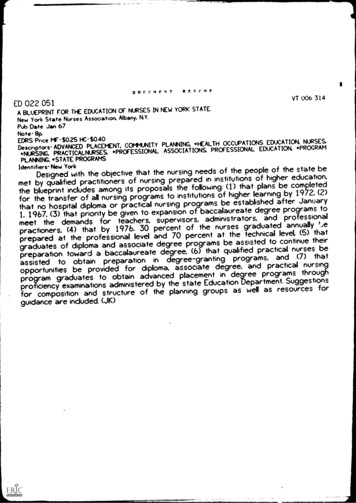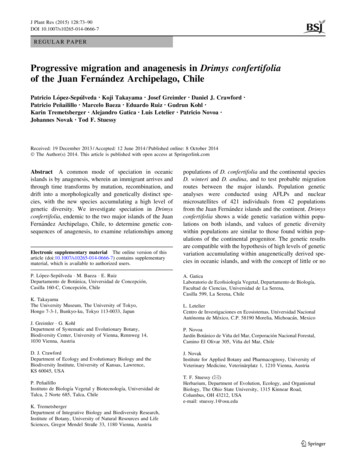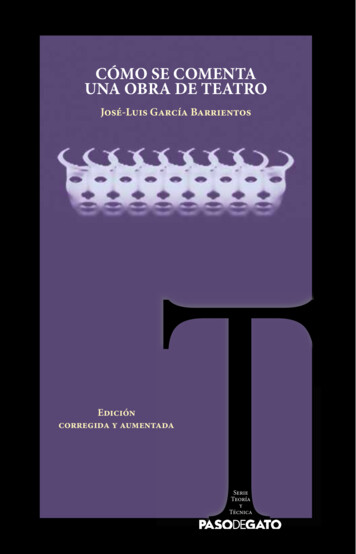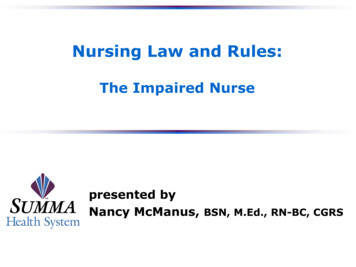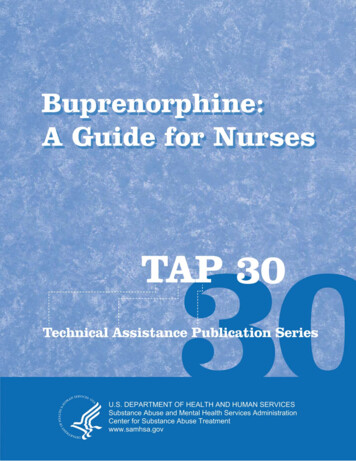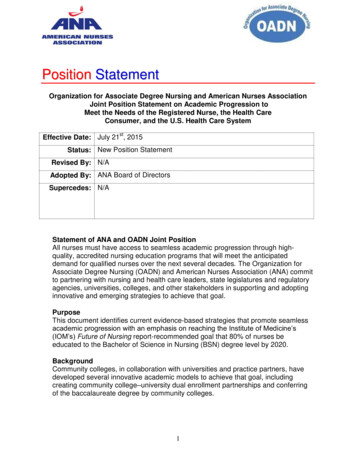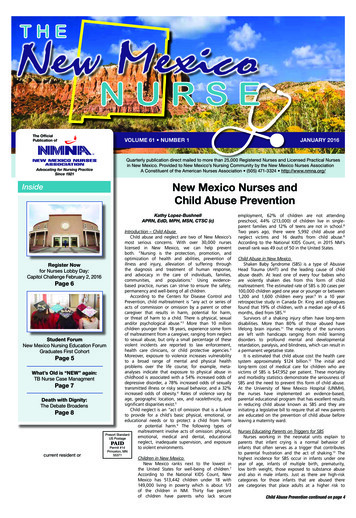
Transcription
The OfficialPublication ofAdvocating for Nursing PracticeSince 1921Volume 61 Number 1JANUARY 2016Quarterly publication direct mailed to more than 25,000 Registered Nurses and Licensed Practical Nursesin New Mexico. Provided to New Mexico’s Nursing Community by the New Mexico Nurses AssociationA Constituent of the American Nurses Association (505) 471-3324 http://www.nmna.org/New Mexico Nurses andChild Abuse PreventionInsideKathy Lopez-BushnellAPRN, EdD, MPH, MSN, CTSC (c)Introduction – Child AbuseChild abuse and neglect are two of New Mexico’smost serious concerns. With over 30,000 nurseslicensed in New Mexico, we can help preventboth. “Nursing is the protection, promotion, andoptimization of health and abilities, prevention ofillness and injury, alleviation of suffering throughRegister Nowthe diagnosis and treatment of human response,for Nurses Lobby Day:and advocacy in the care of individuals, families,Capitol Challenge February 2, 2016communities, and populations.1 Using evidencePage 6based practice, nurses can strive to ensure the safety,permanency and well-being of all children.According to the Centers for Disease Control andPrevention, child maltreatment is “any act or series ofacts of commission or omission by a parent or othercaregiver that results in harm, potential for harm,or threat of harm to a child. There is physical, sexualand/or psychological abuse.”2 More than 10 millionchildren younger than 18 years, experience some formof maltreatment from a caregiver, ranging from neglectto sexual abuse, but only a small percentage of theseStudent Forumviolent incidents are reported to law enforcement,New Mexico Nursing Education Forumhealth care clinicians, or child protective agencies.3Graduates First CohortMoreover, exposure to violence increases vulnerabilityPage 5to a broad range of mental and physical healthproblems over the life course; for example, metaanalyses indicate that exposure to physical abuse inWhat’s Old is “NEW” again:childhood is associated with a 54% increased odds ofTB Nurse Case Managmentdepressive disorder, a 78% increased odds of sexuallyPage 7transmitted illness or risky sexual behavior, and a 32%increased odds of obesity.4 Rates of violence vary byage, geographic location, sex, and race/ethnicity, andDeath with Dignity:significant disparities exist.5The Debate BroadensChild neglect is an “act of omission that is a failurePage 8to provide for a child’s basic physical, emotional, oreducational needs or to protect a child from harmor potential harm.6 The following types ofmaltreatment involve acts of omission: physical,Presort Standardemotional, medical and dental, educationalUS Postageneglect, inadequate supervision, and exposurePAIDPermit #14to violent environments.current resident orPrinceton, MN55371Children in New MexicoNew Mexico ranks next to the lowest inthe United States for well-being of children.7According to the National KIDS Count, NewMexico has 513,442 children under 18 with149,000 living in poverty which is about 1/3of the children in NM. Thirty five percentof children have parents who lack secureemployment, 62% of children are not attendingpreschool, 44% (213,000) of children live in singleparent families and 12% of teens are not in school.8Two years ago, there were 5,992 child abuse andneglect victims and 16 deaths from child abuse.8According to the National KIDS Count, in 2015 NM’soverall rank was 49 out of 50 in the United States.Child Abuse in New MexicoShaken Baby Syndrome (SBS) is a type of AbusiveHead Trauma (AHT) and the leading cause of childabuse death. At least one of every four babies whoare violently shaken dies from this form of childmaltreatment. The estimated rate of SBS is 30 cases per100,000 children aged one year or younger or between1,200 and 1,600 children every year.9 In a 10 yearretrospective study in Canada Dr. King and colleaguesfound that 19% of children, with a median age of 4.6months, died from SBS.10Survivors of a shaking injury often have long-termdisabilities. More than 80% of those abused havelifelong brain injuries.11 The majority of the survivorsare left with handicaps ranging from mild learningdisorders to profound mental and developmentalretardation, paralysis, and blindness, which can result ina permanent vegetative state.It is estimated that child abuse cost the health caresystem approximately 124 billion.12 The initial andlong-term cost of medical care for children who arevictims of SBS is 47,952 per patient. These mortalityand morbidity statistics demonstrate the seriousness ofSBS and the need to prevent this form of child abuse.At the University of New Mexico Hospital (UNMH),the nurses have implemented an evidence-based,parental educational program that has excellent resultsin reducing child abuse known as SBS and they areinitiating a legislative bill to require that all new parentsare educated on the prevention of child abuse beforeleaving a maternity ward.Nurses Educating Parents on Triggers for SBSNurses working in the neonatal units explain toparents that infant crying is a normal behavior ofinfants that often serves as a trigger that contributesto parental frustration and the act of shaking.13 Thehighest incidence for SBS occur in infants under oneyear of age, infants of multiple birth, prematurity,low birth weight, those exposed to substance abuseand also in male infants. Just as there are high-riskcategories for those infants that are abused thereare categories that place adults at a higher risk toChild Abuse Prevention continued on page 4
Page 2 The New Mexico NurseARE YOU LICENSEDTO PRACTICE IN NEWMEXICO?The New Mexico Nurses Associationinvites you to join us today.And help determine the impactof health care reform on nursingpractice.Visit www.nmna.orgfor complete information.January, February, March 2016Give the Board ofNursing yourNEW ADDRESS!If the Board of Nursing sends you anotice and you don’t receive it becausethey don’t have your latest address,you may miss something critical to yourlicense!There is a Name/Address change/Residency Change form atwww.bon.state.nm.us underLicensing FormsNM NURSES NEEDED FOR A NEWPROJECTA Nightingale Tribute was designed and developed by the Kansas StateNurses Association to be used to honor deceased nurses. NMNA wantsto ensure that this basic Nightingale Tribute is offered in a nurse’s funeralshould the nurse, the family so choose. This tribute can be offered for anyRegistered Nurse or Licensed Practical Nurse for their years of service and canbe presented during the nurse’s funeral by a nurse colleague or friend. At anational level at Arlington and in other states, nurses have committed to assistin this endeavor; NMNA will be replicating materials developed by the KansasState Nurses Association and an effort underway in Utah for this option.Any nurse interested in working on this project shouldcontact the NMNA office at: (505) 471-3324.The Molina Healthcarefamily is growing andwe’re hiring now!Positions include:Care Review Clinicians and Field Case LINACAREERSJoin a fun camp communityand spend a summer in theColorado RockiesColvig Silver Camps has an open Nurse position for thesummer of 2016. Overall responsibility for staff and camperhealth, RN licensure required and pediatric experiencepreferred. Salary commensurate with experience and privatecabin/bathroom included. You have kids? We also offer atuition benefit. May 21–August 9.Contact Tyler Dixon 970-247-2564Visit: colvigsilvercamps.comThe New Mexico Nurse is published quarterly everyJanuary, April, July and October by the Arthur L. DavisPublishing Agency, Inc. for the New Mexico NursesAssociation, a constituent member of the AmericanNurses Association.For advertising rates and information, please contactArthur L. Davis Publishing Agency, Inc., 517 WashingtonStreet, PO Box 216, Cedar Falls, Iowa 50613, (800)626-4081, sales@aldpub.com. NMNA and the ArthurL. Davis Publishing Agency, Inc. reserve the right toreject any advertisement. Responsibility for errors inadvertising is limited to corrections in the next issue orrefund of price of advertisement.Acceptance of advertising does not imply endorsementor approval by the New Mexico Nurses Associationof products advertised, the advertisers, or the claimsmade. Rejection of an advertisement does not imply aproduct offered for advertising is without merit, or thatthe manufacturer lacks integrity, or that this associationdisapproves of the product or its use. NMNA and theArthur L. Davis Publishing Agency, Inc. shall not be heldliable for any consequences resulting from purchase oruse of an advertiser’s product. Articles appearing in thispublication express the opinions of the authors; theydo not necessarily reflect views of the staff, board, ormembership of NMNA or those of the national or localassociations.New Mexico Nurse is a juried nursing publicationfor nurses licensed in New Mexico. The Editoral Boardreviews articles submitted for publication and articlesfor consideration should be submitted to dwalker@nmna.org.NMNA Board and StaffPresident: Leigh DeRoos, MSN, RN4644 Sandalwood DriveLas Cruces, NM 88011Hm: 575-521-4362Lderoos49@yahoo.comCell: 575-496-6924term exp. 2015Vice President: Gloria Doherty, MSN, RN, ACNP1905 Rita Court NEAlbuquerque, NM 87106Hm: 505-243-2628gdoherty@salud.unm.eduCell: 505-350-2291term exp. 2016Secretary-Treasurer: Suzanne Canfieldsjcanfield@comcast.netDirectors:Cynde Tagg, DNP(c), MSN-NE, RNctagg@salud.unm.eduRuth Burkhart, MSN, MA, RN, BC, LPCC575-646-5806burkhart@nmsu.eduRomona Scholder, MA, CNS, RN5641 State Highway 41Galisteo, NM 87540Hm: 505-466-0697romonascholder@gmail.comWk: 505-982-5044Theresa S. Ameri, DNP, RN, CNE, CPN, FNP-BCtsameri@gmail.comNMNA Website: www.nmna.orgOffice Mailing Address:P.O. Box 418, Santa Fe, NM 87501Office Phone: 505-471-3324A 25-bed licensed critical access hospitalis actively recruiting Registered Nurses for: L&D/Post Part/Nursery Emergency Room ICU Med/Surg House SupervisorExecutive Director: Deborah Walker, MSN, RN3101 Old Pecos Trail #509Santa Fe, NM 87505Office: 505-471-3324Cell: 505-660-3890Continuing Education Coordinator:Carolyn Roberts, MSN, RNOffice Phone: 505-471-3324ceapps@nmna.orgWe are located in a resort community at 7000’ elevation,recreational activities include down-hill skiing in the winter, andquarter horse racing, as well as cultural arts in the summer.An affiliate of Presbyterian Healthcare Services, EOE, we offercompetitive salaries with a comprehensive benefit package.www.nmna.orgTo learn more about Lincoln County Medical Center, Ruidosoand to apply online go towww.phs.orgWe are an equal opportunity employer and all qualified applicants will receive considerationfor employment without regard to race, color, age, religion, sex, national origin, sexualorientation, gender identity, disability status, protected veteran status, or any othercharacteristic protected by law. PHS is committed to ensuring a drug-free workplace.Published by:Arthur L. DavisPublishing Agency, Inc.
January, February, March 2016The New Mexico Nurse Page 3President’s MessageLeigh DeRoos BSN, MSPresident New Mexico Nurses AssociationThank you for your support over the last two years and for re-electing me to servemy second term as President of the New Mexico Nurses Association. At the recentNMNA annual meeting, I informed the members that the state of our association issolid and I am very happy to say that the New Mexico Nurses Association (NMNA)has seen not only an increase in membership but, more importantly, an increase inmember involvement. It is because of this member engagement that we continue toexpand our voice and our advocacy in New Mexico.Nurses in New Mexico, through NMNA, have a history of a strong lobbyingpresence and have therefore long enjoyed a progressive practice environment stillnot achieved in many states. Nurses have had a voice at the national level throughthe American Nurses Association (ANA) : “When nurses talk Washington listens.”National Lobby Day for nurses is held in Washington DC in conjunction with the ANAMembership Assembly. NMNA was well represented on the Hill this year. Nurses whoattend the DC lobbying event overwhelmingly state how beneficial and educationalit is to meet with their elected officials to discuss issues that impact nurses and theirstates. They return to their respective states re-invigorated with a proactive mindsetand a willingness to become more involved in health care policy issues that impacttheir states. The nurses who attend also come away with an increased understandingof Congressional staff in Washington. In addition, NMNA members have served oninitiatives at the national level that allow them to impact health care policy issuesnationally. This year we were fortunate enough to send two of our members to theANA’s American Nurse Advocacy Institute (ANAI), a year -long mentoring program“designed to develop a strong cadre of registered nurses equipped to influence healthpolicy at the local, state and national levels” (American Nurse Advocacy Institute, n.d.). (See Nurses in our News for more information).At the state level, we continue nursing’s voice on a range of fronts. We engageour elected representatives through both our contracted lobbyist, Linda Siegel, andthrough our Executive Director and registered lobbyist, Deborah Walker. In addition,at Capitol Challenge (Nurses’ Lobby Day February 2, 2016), our annual legislativeconference, nurses throughout our state have the unique opportunity to meetwith their elected representatives and use their voice to promote issues that impactnurses and their communities. NMNA, working with nurse producer/director CamilleAdair, has developed a diversity video which complements the Nursing DiversityInstitute chaired by Lisa-Marie Turk. If you have not seen the video, you can accessit at NMNA’s website -www.nmna.org. Also, mirroring national affiliation betweenANA and specialty associations, we have nursing organizations that have affiliatedwith NMNA, such as the NM Native American Nurse Association, the NM chapter ofOncology Nurses, the NM Holistic Health Nurses, the NM Nurse Practitioner Counciland the NM Nephrology Nurses. At the annual meeting, many of the specialty nursingorganizations came together for a Nursing Issues Forum and the consensus was that,regardless of the organization we, as a profession, have many issues in common andthe issues forums need to continue.To continue our increasing member involvement and to provide options formembers regardless of geographic location, the New Mexico Nurses Association isdeveloping interest groups that address your issues and your concerns. One of ourinterest groups is health councils. Presently, we have members actively engaged inhealth councils throughout the state to lend their expertise. In our larger cities, weMORE than a nurse.It’s about becoming a leader.Online Graduate Certificates Leadership in Healthcare Systems Certificate Nursing Clinical Leadership Certificate15 credit-hour graduate certificates offeredby an accredited & established university.Online RN–BSNProgramAffordable. Flexible. AvailableAnywhere. CCNE Accredited.nursing.wnmu.edualso have nurses monitoring city council and county commission meeting agendasand attending when appropriate. We have NMNA members participating in the TaskForce for Health Care Transitions in our state. Not only do NMNA members serveon healthcare committees, such as the Team Pregnancy Prevention Work Group inLas Cruces, I was recently asked by Congressman Pearce’s office to participate in aroundtable discussion on the impact of the Affordable Care Act on New Mexicans.NMNA is focusing on developing programs for the unique needs of the new RN.There is a new graduate advisory committee composed of recent new graduatenurses who advise NMNA on concerns and issues of new RNs. Under the leadershipof Ed Chacon, BSN and Jason Bloomer BSN, NMNA has developed a Welcome tothe Profession program to help new RNs to transition into the profession of nursing.In addition, NMNA is rolling out a mentoring project based on ANA’s mentoringprogram, but tweaking it to reflect the needs of new RNs working in New Mexico.This mentoring program is a member-only benefit designed to match new RNs witha nurse having more than 5 years of experience. NMNA understands the importanceof a new RN having a supportive and nurturing relationship with an experienced RNduring the crucial transition from nursing school to nursing practice. Our mentoringprogram is designed to facilitate this. If any members are interested in helping withthis mentoring project, please go the ANA website and register at www.ana.orgAs I begin my new term, I asked that if you are a member please considerbecoming involved in one of the interest groups. Volunteer to become involved inhealth councils in your area or if you have a concern or issue that an interest groupcould address, please contact me or Deborah Walker in our Santa Fe office at 505471-3324. Your active involvement is invaluable and we want to be meeting memberneeds. We provide orientation for most of the volunteer opportunities. If you are notmember, please join and become a voice at the table. We are 3 million strong andwe can make a difference. With your involvement, we will continue to expand ourinfluence throughout the state. I always welcome your comments and questions atnursesempowered@gmail.com.ReferenceAmerican Nurses Advocacy Institute. (n. d.) . Frequently Asked Questions. ategories/Policy-Advocacy/AdvocacyResourcesTools/ ANA-FAQ.pdf
Page 4 The New Mexico NurseChild Abuse Prevention continued from page 1be perpetrators. Perpetrators are more often males with less formal education,younger, unmarried, part of a dysfunctional family or who experienced previousabuse and were frequently identified as being the mother’s boyfriend, the fatheror stepfather.14 It is important to know that parental risk factors for abuse identifiedinclude substance abuse (53%), domestic violence (42%), criminal history (32%),unrealistic expectations (42%) and attachment problems (32%).14Evidence-Based Interventions to Prevent Child AbuseResearch has demonstrated that hospital-based education to parents is effective inimproving parental education about SBS.13 At UNMH 802 parents of newborns in theIntensive Care Nursery (ICN) or Neonatal Intensive Care Unit (NICU) received a shorteducational session about infant crying and SBS, a pamphlet, saw a video and gavewritten permission for a 7-month follow-up call to find out what they remembered. Thisstudy demonstrated that 99% parents found this information to be helpful and 17%stated that this was the first time they had heard that shaking a baby is dangerous.From January 2012 to September 2014 there were 39 incidences of diagnosed SBS inNew Mexican infants who were discharged from units outside of the ICN and NICU atUNMH. During the same time period there were zero infants who were discharged fromICN and NICU that were subsequently diagnosed with SBS (p 0.05).The most effective violence prevention strategies include parent and family-focusedprograms, early childhood education, school-based programs, therapeutic or counselinginterventions, and public policy. For example, a systematic review of early childhoodhome visitation programs found a 38.9% reduction in episodes of child maltreatment inintervention participants compared with control participants.GrandOpening SaleScrubs, lab coats, stethoscopes,shoes, medical supplies, & accessories–from all your favorite brands!Enter code OPEN to save 15% on all orders!January, February, March 2016Nursing Prevention Strategies for Child AbuseSome evidence-based interventions that nurses can implement to reduce child abuseinclude the Nurse-Family Partnership, Child-Parent Centers (CPC), Safe Environmentfor Every Kid and Parent-child Interaction Therapy.15 New Mexico has the Nurse-FamilyPartnership that is a home visitation program for evidence-based public policy with morethan 37 years of evidence of effectiveness. The CPC also has data of its comprehensiveeducational support of economically disadvantaged children and their parents whichfollowed 1,539 low-income minority students for 19 years and found that they outperformed, had higher school retention, lower felony convictions and were lessdepressed than the control group.16There are many programs that can help prevent child abuse and if every nurse inNew Mexico worked with families, health institutions, schools, day care centers andother community organizations to increase the awareness and provide education andneeded support for families, we could prevent this unnecessary child maltreatment.Understanding child abuse prevention and what to do when children are at risk is animportant part of nursing care. There is much information on child and family wellbeing and resources on protective factors including marriage, fatherhood and parenting.Nurses are the leaders for sharing a child abuse prevention message with communitiesand building community support.All nurses are welcome to use the tools, resources and information on the UNMHospital SBS website. This website has the script for education of SBS prevention, waysto cope with crying, babysitter information as well as the hand out and a link to thevideo“When Babies Cry” by the Shaken Baby Alliance.If you have any questions or concerns, please feel free to contact the author and/orcontact the ment/definitions.html3. eillance.html4. data-book/5. eillance.html6. a#NM/2/08. data-book/9.Centers for Disease Control and Prevention, (CDC) National Center for InjuryPrevention and Control (2010). Preventing shaken baby syndrome: A guide forhealth departments and community based organization. Retrieved from http://www.cdc.gov/Concussion/pdf/ Preventing SBS 508-a.pdf10. King, W., MacKay, M., Sirnick, A., & the Canadian Shaken Baby Study Group.(2003). Shaken baby syndrome in Canada: Clinical characteristics and outcomes ofhospital cases. Canadian Medical Association Journal, 168(2), 155-159.11. American Academy of Pediatrics: Committee on Child Abuse and Neglect. (2001).Shaken baby syndrome: Rotational cranial injuries-technical report. Pediatrics,108(1), 206-210. doi:10.1542/peds.108.1.20612. Centers for Disease Control and Prevention, (CDC) National Center for InjuryPrevention and Control (2010). Preventing shaken baby syndrome: A guide forhealth departments and community based organization. Retrieved from http://www.cdc.gov/Concussion/pdf/ Preventing SBS 508-a.pdf13. Dias, M., Smith, K., deGuehery, K., Mazur, P., Li,V., & Shaffer, M. (2005). Preventingabusive. Head trauma among infants and young children: A hospital-based, parenteducation program. Pediatrics, 115(4), e470-e477. doi:10.1542/peds.2004-189614. Simmonnet, H., Laurent-Vannier, A., Yuan, W., Hully, M., Valimahomed, S.,Bourennane, M., & Chevignard., M. (2014). Parents’ behavior in response to infantcrying: abusive head trauma education. Child Abuse & Neglect, 38(12), 1914-1922.15. tment/prevention.html16. oms/Stories-from-moms/Crystal-s-storySummit Healthcare Regional Medical CenterTrusted to Deliver Exceptional, Compassionate care close to homeCome to Arizona’s cool, beautiful WhiteMountains where the quality of life soarsas high as the tall pines!Sign on bonus / Relocation Assistance /Excellent Benefits / 403(b) Retirement /Tuition ReimbursementRN opportunities in: Emergency Dept. Med Surg Surgery ICU Float Labor & Delivery /Post Partum Home Health RN - Wound Care RN - Cath LabTo learn more about our Career opportunitiesvisit www.summithealthcare.netor call to speak with the Nurse Recruiter,Stevie Burnside at 928-537-6367email sburnside@summithealthcare.netVisit ShopNurse.com today!Show Low Arizona has four beautiful,mild seasons — a perfect place foroutdoor adventures year-round!Summit Healthcare Regional Medical Center2200 E. Show Low Lake Rd. Show Low, AZ 85901
January, February, March 2016The New Mexico Nurse Page 5Student ForumNEW MEXICO NURSINGEDUCATION CONSORTIUMGraduates First CohortUNM Student Nurses Assocation Has aCommitment to Community ServiceThe NMNEC statewide program designed to increase the number of nurses earningpre-licensure BSN degrees in New Mexico graduated its first cohort August 21. UNMand CNM students stood side-by-side as the first graduating cohort. CNM studentsearned their baccalaureate degrees through a partnership with UNM allowing thestudents dual-enrollment.“To congratulate our first graduates and see the impact that they will have on theircommunities is a great source of pride for me and the entire state of New Mexico,” saidNancy Ridenour, PhD, RN, Dean of the UNM College of Nursing.Diane Evans-Prior, CNM Academic Affairs Director ofNursing, congratulates a dually-enrolled UNM-CNM graduate.The common nursing curriculum encourages students to not only pursue their BSNdegrees in their home communities, it encourages them to seek employment andprovide health care in their own communities.Diane Evans-Prior, DNP(c), RN, CNM Academic Affairs Director of Nursingcommented, “The partnerships that are being forged between the community collegesand the universities are reshaping the landscape of nursing education and bringingbaccalaureate education to students who might not have had the opportunity before. Itis an exciting time to be a nursing student in New Mexico.”The common curriculum is now taught in eleven locations throughout the state.Ten of those locations offer the pre-licensure BSN. By 2019, it is projected that everyADN and pre-licensure BSN state-funded nursing program will be teaching the commoncurriculum paving the way to seamless transfer as well as offering BSNs in ruralcommunities throughout New Mexico.August 21, 2015 UNM graduates the first cohort to complete the commonstatewide curriculum – 64 BSN graduates of which eight completed theircoursework while attending CNM through a partnership with UNM.San Carlos Apache Healthcare CorporationIzeé Baa Gowáh - Join our team!Seeking FNPs and RNsGenerous compensation and benefits package!Beautiful new hospital campus located 2 hourseast of Phoenix, AZPlease apply online by going For more information please contact ourHR Center at 928-475-1251October 17, 2015—The University of New Mexico College of Nursing Level3 students showing their spirited side as they volunteer administering flushots at the Health Sciences Student Council Drive Flu Shot Clinic to thepublic. Increasing the ‘herd immunity’ by vaccinating students, employees,and residents of Albuquerque, New Mexico; these students practiced safeadministration of vaccines, directed traffic, and exercised interpersonalcommunication. By working with pharmacy students, medical students,emergency medical students, and other nursing schools, more than 2,000individuals were prepared for the upcoming season.
Page 6 The New Mexico NurseJanuary, February, March 2016Congratulations to the NewlyElected and Continuing Membersof the Board of Directors,Nominating Committee andRepresentatives of the NewMexico Nurses Association!!REGISTRATION FORM: CAPITOL CHALLENGE 2016NURSES DAY AT THE NEW MEXICO STATE CAPITOLPresident of NMNALeigh DeRoosTuesday, February 2, 20167:30 am - 4:00 pmHotel Santa Fe, Santa Fe, NMVice-PresidentGloria DohertySecretary/TreasurerSuzanne CanfieldBoard of DirectorsTheresa AmeriRuth BurkhartRomona ScholderCynde TaggChair of Nominating CommitteeAndrew VickMembership AssemblyRepresentativesEdward ChaconLeigh DeRoosInterest Group ChairsCamille AdairFran A’hern SmithJason BloomerEd ChaconLisa Marie TurkThis continuing education activity has been approved by the Montana Nurses AssociationAccredited Approver Unit, an accredited approver by the American Nurses CredentialingCenter’s Commission on Accreditation. Participants will receive 6.25 contact hours.NameEmailPhone ( )AddressCity Zip codeREGISTRATION FEES“I’m a member of NMNA or NMNA affiliated association” – 90 I’m not yet a member” – 125Fee is inclusive of breakfast, breaks, lunch, and continuing nursing education contact hours.Hotel Santa Fe reservations: 1-505-982-1200. Parking is free at Hotel Santa Fe and room fee isinclusive of deluxe continental breakfast.Contact Deborah Walker RN, MSN with any questions at: dwalker@nmna.org; or call (505) 660-3890 forimmediate assistance. Mail registration form and check made payable to NMNA by January 25, 2016 to:NMNAP.O. Box 418Santa Fe, NM 87504PLEASE NOTE: Any cancellations must be received no later than January 26th.Criteria for Successful Completion: You must register, sign in, attend the entire workshop, completeand submit an evaluation form at the conclusion of the workshop in order to receive CNE contact hours.www.fnch.orgFirst Nations Community HealthSource is a localnon-profit community based healthcare facilitylocated in SE Albuquerque.We are currently recruiting for the following position: Registered Nurse:Responsible for assisting with directpatient care, triage, etc. in a familypractice clinic. NM State License required.FNCH offers a Full Employee Benefits Package.Please send
Head Trauma (AHT) and the leading cause of child abuse death. At least one of every four babies who are violently shaken dies from this form of child maltreatment. The estimated rate of SBS is 30 cases per 100,000 children aged one year or younger or between 1,200 and 1,600 children every year.9 In a 10 year


